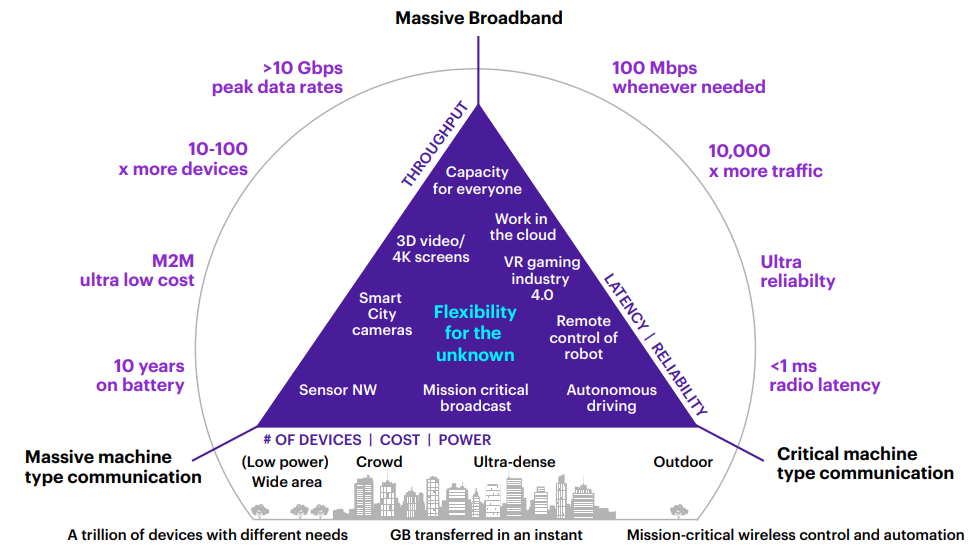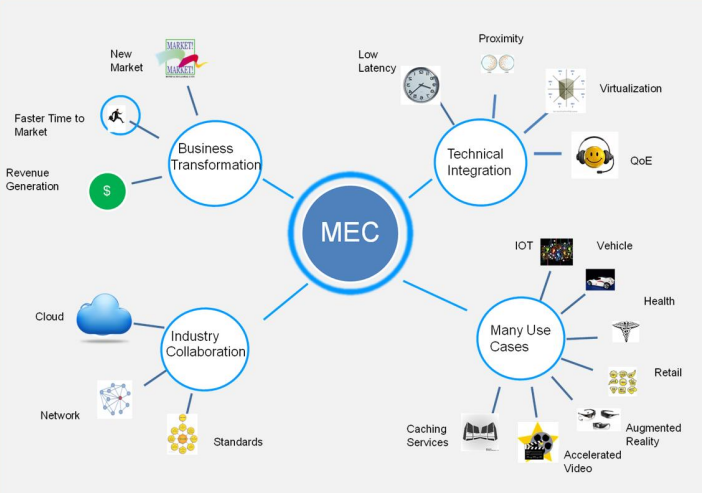Introduction
MEC (Mobile Edge Computing) transforms the topology and architecture of mobile networks from pure communication networks for voice and data to an application platform for services. The MEC should be seen as complementing and enabling the service environment that will characterize 5G.
While previous generations of mobile communication networks, such as 2G, 3G, and 4G, focused primarily on media interaction – connecting people across different places – 5G will enable multiple use cases, including working in the cloud, remote control of robots, VR gaming, AR for predictive maintenance, autonomous driving, and automation.
5G New Use Cases
The 5G triangle, which illustrates potential use cases considering the main capabilities of the new generation of mobile networks. The number of these use cases, including:
- V2X and Connected Car, This concept aims to increase transportation safety, improve travelers’ experience, decrease environmental
impact, and improve transportation efficiency. - e-Health, MEC can help enable more robust communication, higher-speed data rates, and lower latency for such uses as ambient assisted
living, elder care, or more sophisticated prosthetics supported by environmental sensor data. - Enhanced experiences at public venues, Initial studies, and experiments have received very positive feedback from end-users. Use cases include locally produced live video streams at stadiums, with replays from different camera angles, and AR and VR experiences at such venues as shopping malls and amusement parks.

5G Triangle
Each of these use cases requires the proper mix of service qualities that can be classified into throughput, reliability, and latency. Within 5G standardization, they are referred to as MBB (mobile broadband), MTC (machine type communication), and URLLC (ultra-reliable low-latency communication).
What is MEC?
Mobile Edge Computing (MEC) is a new technology that is currently being standardized in an ETSI Industry Specification Group (ISG) of the same name. Mobile Edge Computing provides an IT service environment and cloud-computing capabilities at the edge of the mobile network, within the Radio Access Network (RAN), and in close proximity to mobile subscribers. The aim is to reduce latency, ensure highly efficient network operation and service delivery, and offer an improved user experience.
Mobile Edge Computing opens up services to consumers and enterprise customers as well as to adjacent industries that can now deliver their mission-critical applications over the mobile network. It enables a new value chain, fresh business opportunities, and countless of new use cases across multiple sectors.
MEC Market Driver
The growth of mobile traffic and pressure on costs are driving a need to implement several changes in order to maintain quality of experience, to generate revenue, and optimize network operations and resource utilization. The Internet of Things is further congesting the network and network operators need to do local analysis to ease security and backhaul impacts. Enterprises want the ability to enable and engage with their customers with more efficient, secure, and low latency connections. Application and content providers are challenged with the latency of the network when connecting to the cloud.
Mobile operators need to shorten the time to launch new revenue-generating applications for current customers but also for specific industries and sectors, such as but not limited to automotive, industrial automation, and welfare industries. Business transformation based on collaboration with the different players in the value chain can help in facing these challenges.
The market drivers of MEC include business transformation, technology integration, and industry collaboration. All of these can be enabled by MEC and a wide variety of use cases can be supported for new and innovative markets, such as e-Health, connected vehicles, industry automation, augmented reality, gaming, and IoT services.

MEC Market Drivers
Why MEC!
The massive centralized data centers in the backbone of mobile communication networks, known also as cloud services platforms, will perform adequately in providing computation and other services.
Unfortunately, when considering some 5G use cases which require 1ms URLLC, this concept has a huge disadvantage. A signal or data packet which needs to travel between a mobile device and the cloud usually travels several hundred kilometers in order to be processed in the data center, which leads to a round trip time (RTT) of several dozen milliseconds.
To put this in numbers, consider that the propagation delay of a signal or data package within a modern fiber-optic network is limited by the speed of light, which is around 300.000 km/s in a vacuum.
To achieve a round-trip time (RTT) of less than 1 ms, the maximum distance between a mobile
device and a cloud can be no greater than around 100km. Considering that additional time needs to be allowed for sensors to collect data, for embedded or cloud computing to take place, for in-network elements to be processed, and for the actuator to react, then the maximum distance to achieve 1 ms RTT becomes even lower and should be no more than 10 to 20 km.
From the user’s point of view, data centers provide services and are in essence the core or the “heart” of the internet (network). It is not feasible to build big data centers every 10 km in order to bring the internet to the user more quickly.
From the network operator’s point of view, however, the closest places or “hops” to a user are the base stations at the edge of the network. Those base stations can be utilized to outsource the cloud closer to the user, and therefore to provide low latency and enable new use cases.
The concept of “mobile edge computing” or the “edge cloud” describes the use of the network’s edge to provide cloud services, as well as one additional aspect. Due to the mobility of end-user devices, a possible edge cloud must also be mobile. This means that an application or service running in an edge cloud needs to be migratable without any visible downtime for the user. Because an agile/mobile cloud can now be accessed through different endpoints, it is therefore referred to as a mobile or MEC.
Augmented Reality Scenario
New services become possible when mobile networks supporting high data rates and low latency computation are deployed. One example of such services is Augmented Reality.

Augmented Reality Service Scenario
Augmented reality (AR) is the combination of a view of the real-world environment and supplementary computer-generated sensory input such as sound, video, graphics, or GPS data. Augmented reality can enhance the experience of a visitor to a museum or another point of interest.
Consider a visit to a museum, art gallery, city monument, music, or sports event, holding their mobile device towards a particular point of interest with the application related to their visit activated (i.e., the museum application). The camera captures the point of interest and the application displays additional information related to what the visitor is viewing.
Augmented reality services require an application to analyze the output from a device’s camera and/or a precise location in order to supplement a user’s experience when visiting a point of interest by providing additional information to the user about what they are currently experiencing. The application needs to be aware of a user’s position and the direction they are facing, either through positioning techniques or through the camera view, or both.
After analyzing such information, the application can provide additional information in real-time to the user. If the user moves, the information needs to be refreshed. Hosting the Augmented Reality service on a MEC platform instead of in the cloud is advantageous since supplementary information pertaining to a point of interest is highly localized and is often irrelevant beyond the particular point of interest. Figure 3 shows how a MEC platform can be used to provide an Augmented Reality service.
Conclusion
MEC integrates traditional cellular telecom networks with Internet services to reduce end-to-end latency of user service interaction and improve user experience by exposing the capabilities of mobile networks.
The MEC will be able to create new use cases and support particular scenarios where high data rates and low latency are expected. So, the ability to provide content and services at the closest point to the user unveils new opportunities to launch services requiring performance that previously would not have been satisfied by the use of an operator’s network and centralized architectures.
References
- Mobile Edge Computing A key technology towards 5G, ETSI.
- 5G MEC IP Network White Paper, Huawei.
- MEC for pervasive networks, Accenture.
- 5G MEC Based Cloud Game Innovation Practice, GSMA.












